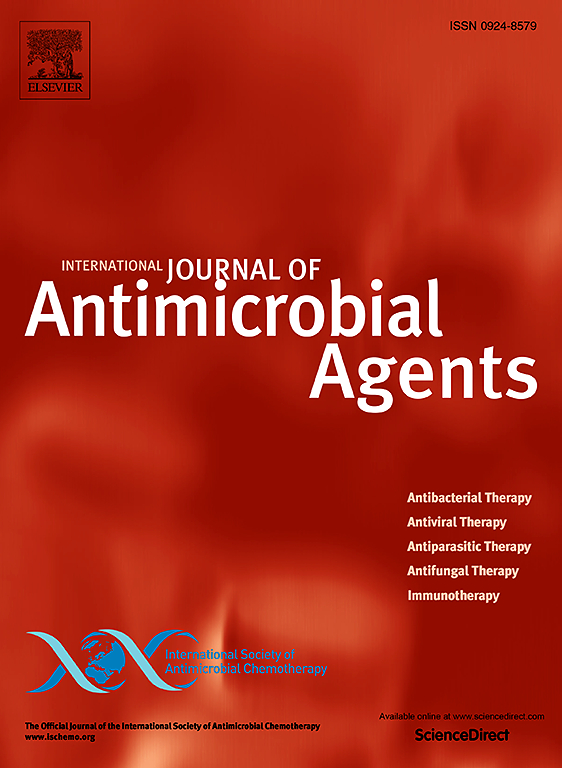比较头孢他啶/阿维巴坦和多粘菌素B治疗碳青霉烯耐药菌感染:倾向评分匹配的回顾性队列研究
IF 4.9
2区 医学
Q1 INFECTIOUS DISEASES
International Journal of Antimicrobial Agents
Pub Date : 2024-12-20
DOI:10.1016/j.ijantimicag.2024.107418
引用次数: 0
摘要
背景与目的:头孢他啶/阿维巴坦(CAZ/AVI)与多粘菌素B (PMB)治疗碳青霉烯耐药菌(CRO)感染的比较研究有限。我们旨在比较CAZ/AVI和PMB治疗CRO感染的疗效和安全性。方法:这项单中心、倾向评分匹配(PSM)的回顾性队列研究纳入了CRO感染的成年患者。接受以CAZ/ avi为基础的方案的患者被纳入队列组,而以pmb为基础的方案的患者被纳入对照组。主要终点为28天全因死亡率。结果:298例符合条件的患者中,每组96例患者纳入PSM队列。与PMB组相比,CAZ/AVI组28天和14天的全因死亡率没有改善,14天的临床反应也没有改善。然而,在碳青霉烯耐药铜绿假单胞菌(CRPA)感染和单药治疗亚组中,基于CAZ/ ai的方案显示出比基于pmb的方案更高的14天临床缓解率。CAZ/AVI组的CRO根除率高于PMB组(粗OR为1.658;95% ci, 1.108-2.480;P = 0.014;调整OR为1.718;95% ci, 1.055-2.798;P = 0.030)。CAZ/AVI根除CRO的优势在大多数亚组中是一致的,包括感染性休克、血流感染和下呼吸道感染。CAZ/AVI组和PMB组肾毒性相当(粗OR 0.577;95% ci, 0.306-1.089;P=0.090,校正OR为0.741;95% ci, 0.361-1.521;P = 0.414)。结论:以CAZ/ avi为基础的方案与以pmb为基础的方案治疗CRO感染的临床疗效和肾毒性相似。但CAZ/AVI在清除CRO和治疗CRPA感染方面优于PMB。CAZ/AVI单药治疗CRO感染比PMB单药治疗更有效。试验注册:ChiCTR2300078790预期于2023年12月19日注册(https://www.chictr.org.cn)。本文章由计算机程序翻译,如有差异,请以英文原文为准。

Comparing ceftazidime/avibactam and polymyxin B for treating carbapenem-resistant organisms infections: A propensity score-matched retrospective cohort study
Background and aim
There are limited comparative studies of ceftazidime/avibactam (CAZ/AVI) vs. polymyxin B (PMB) for carbapenem-resistant organisms (CRO) infections. The aim of this study was to compare the efficacy and safety of CAZ/AVI and PMB in treating CRO infections.
Methods
This single-centre, retrospective cohort study with propensity score-matching (PSM) involved adult patients with CRO infections. Patients who received the CAZ/AVI-based regimen were included in the cohort group; those prescribed with the PMB-based regimen were included in the control group. The primary outcome was 28-day all-cause mortality.
Results
Among 298 eligible patients, 96 patients in each group were included in the PSM cohort. The CAZ/AVI group showed no improvement in 28-day or 14-day all-cause mortality, nor in 14-day clinical response, compared to the PMB group. However, the CAZ/AVI-based regimen was associated with higher 14-day clinical response rates than the PMB-based regimen in subgroups with carbapenem-resistant Pseudomonas aeruginosa (CRPA) infections and monotherapy. The CAZ/AVI group achieved greater CRO eradication than the PMB group (crude odds ratio [OR], 1.658; 95% confidence interval [CI], 1.108-2.480; P = 0.014; adjusted OR, 1.718; 95% CI, 1.055-2.798; P = 0.030). This advantage in CRO eradication with CAZ/AVI was consistent in most subgroups, including septic shock, bloodstream infection and lower respiratory tract infection. The CAZ/AVI and PMB groups had comparable nephrotoxicity (crude OR, 0.577; 95% CI, 0.306-1.089; P = 0.090; adjusted OR, 0.741; 95% CI, 0.361-1.521; P = 0.414).
Conclusion
CAZ/AVI-based and PMB-based regimens demonstrated similar clinical efficacy and nephrotoxicity in treating CRO infections. However, CAZ/AVI was superior to PMB in CRO eradication and treating CRPA infections. CAZ/AVI monotherapy was more effective than PMB monotherapy for CRO infections.
Trial registration
ChiCTR2300078790 prospectively registered on 19 Dec 2023 (https://www.chictr.org.cn).
求助全文
通过发布文献求助,成功后即可免费获取论文全文。
去求助
来源期刊
CiteScore
21.60
自引率
0.90%
发文量
176
审稿时长
36 days
期刊介绍:
The International Journal of Antimicrobial Agents is a peer-reviewed publication offering comprehensive and current reference information on the physical, pharmacological, in vitro, and clinical properties of individual antimicrobial agents, covering antiviral, antiparasitic, antibacterial, and antifungal agents. The journal not only communicates new trends and developments through authoritative review articles but also addresses the critical issue of antimicrobial resistance, both in hospital and community settings. Published content includes solicited reviews by leading experts and high-quality original research papers in the specified fields.

 求助内容:
求助内容: 应助结果提醒方式:
应助结果提醒方式:


